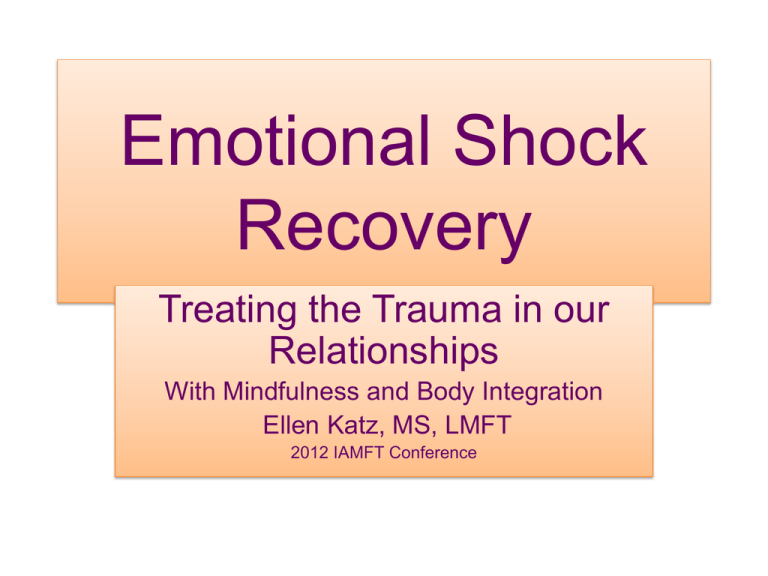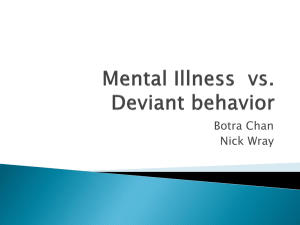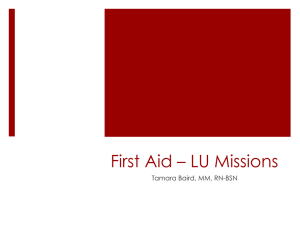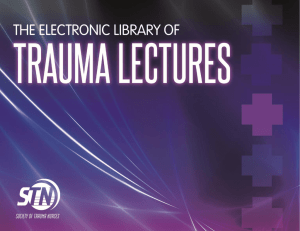Part 1 - Ellen Katz MS, LMFT
advertisement

Emotional Shock Recovery Treating the Trauma in our Relationships With Mindfulness and Body Integration Ellen Katz, MS, LMFT 2012 IAMFT Conference Why are we talking about this?!! Newly emerging understanding of neuroscience, energy medicine, the bio-physiology of trauma, mindfulness and reconnection with traditional indigenous medicine is evolving into a new paradigm of human relationships, communication and healing. Emotion is information. It has meaning. It can be intentionally tracked, generated, contained, directed and utilized. I believe we need to language this – to create a map that helps us conceptualize and engage what we are learning – so that we can give it away. This power is the power of choice. -- Ellen Katz Let’s play with the dynamic qualities of our process! ♫ ♬ ♫♪♩ ♫ Integration ♫ Creativity Receptivity Presence Breath ♫ Inter-connectedness Sensing ♫ Emotional Intelligence Intuition Data Instinctive Wisdom Heart-Based Wisdom Before we start… Let’s get connected. Deeply being with ourselves in this moment, let’s breathe. Taking five slow, gentle, deep inhales – each time pausing and then exhaling equally as slowly and mindfully, watch the breath, and pay attention to the body’s response. Notice how pausing impacts you. Is there a sense of expansion? Are you aware of physical sensations? How does silence feel? Non-Judgment / Equanimity / Neutral Mind Wu Wei = Open Curiosity One of the most challenging - and rewarding - gifts of mindfulness is cultivating the ability to be present. Softly witnessing our thoughts – as passing clouds, cresting waves, pulsing currents of energy that emerge and dissipate – allows us to begin to identify with being the observer of our thoughts. This is the conscious alternative to being affronted randomly by habituated thought impulses! Mindful, Integrated Breath • Continuous Flow Breath, which engages the abdomen, solar plexus and chest, rhythmically and gently opening, pausing briefly, releasing and pausing briefly, is the integrated, complete breath. • This breath regulates our systems and creates internal coherence between brain (nervous system) and heart. • Let’s practice! The Interrupters: Shock and Trauma Two phenomena can cross-wire, over-ride or short-circuit our basic fluid, self-restoring nature to be responsive, resourceful, resilient and creative. These are shock and trauma. Let’s explore them now. Trauma is “a breach in the protective barrier against stimuli leading to feelings of overwhelming helplessness.” -- Sigmund Freud, from Lectures and Beyond the Pleasure Principle, International Psycho-Analytic Press, 1922 Trauma is an event – ie. shock, danger or violation and it is also the response which can extend indefinitely, recur periodically, and even surface after long periods of time. P. Levine, Waking the Tiger “Shock begins the moment when we are confronted with an experience so stunning that our body/mind system is overwhelmed.” - S. Mines, We are All in Shock Shock is cumulative, which is its biggest danger. We carry it in our memory – conscious and unconscious. It becomes less threatening to our health when it is exposed, addressed, understood, relieved and released. Sample Shock Triggers - A baby separated from his or her mother at birth - A child in need of attention who is ignored by busy parents - Witnessing the death of a friend or loved one - Losing a body part, a child, or your possessions in a natural disaster Trauma strikes and wounds; Shock shatters us. Protective Reactions to Trauma When threat, provocation, deprivation or invasion is sensed, all organisms engage these survival responses to self-protect and/or restore their systems: 1. fight - Hyperarousal 2. flight - Constriction 3. freeze - Dissociation 4. “feigned fatality” – Freezing associated with the feeling of helplessness(full systemic shut down). “The terminology regarding shock and trauma is in flux… which represents growth, evolution and needed change.” - S. Mines • From the medical perspective, trauma typically refers to a wounding or bodily injury (ie. trauma to an area of the body) • Shock typically refers to a nervous system condition that radically lessens or even eliminates the ability to feel sensation. • Trauma then tends to be specific, where shock tends to be more global. Shock can be more difficult to track, more unpredictable and insidiously involved in seemingly unrelated aspects of our lives. • Shock occurs when an experience overrides all our healthy coping mechanisms. Our normal, balanced neurological and endocrine responses to threat become confused, fragmented and distorted. • We are designed to process trauma by immediately accessing the limbic-reptilian brain. It takes us through the process needed to release the energetic charge initiated by the traumatic event. This can be externally facilitated in an orderly way through re-scripting, EMDR, Holographic Memory Resolution, Somatic Experience and other modalities. • The overriding and extreme nature of shock is an all system alert. • We want to recognize symptoms of shock as they arise. They will be expressed through the Autonomic Nervous System (ANS): either the Parasympathetic (PNS), Sympathetic (SNS) or both. Shock Trauma • Shock trauma - when an external force ruptures the protective container of our experience, creating a turbulent vortex. • There is an intense loss of life-energy following the rupture, creating a trauma vortex. • Survivors often succumb to getting “sucked back” into the vortex or attempt to avoid the breach by staying distanced from any possible triggers. -- Levine, Waking the Tiger The Physiology of Trauma and Shock • Trauma is expressed in the body through excited or repressed autonomic nervous system activity (ANS) via the sympathetic and parasympathetic nervous systems (SNS and PNS). • The 10th cranial nerve (the vagus nerve) originates in the brain stem and its fibers extend into the colon. It immediately impacts all ANS functioning, including heart rate, blood pressure, hormone secretion, respiration, perspiration, digestion, peristalsis and organ and glandular restriction and activation. The Autonomic Nervous System responses form patterns and generate our Pain Body – our energetic constellation of cumulative Shock. Parasympathetic Response Sudden overwhelming stimulus Sympathetic Response Common Indicators of Shock S. Mines, We Are all in Shock, p. 61-62 Sympathetic Dominance Parasympathetic Dominance Rapid blinking Reddening of the skin Edgy laughter Fidgeting Profuse sweating in social situations Compulsive talking Muscular hyper-tonicity Emotional outbursts Exaggerated startle; long duration Laughing as describing charged situation Sudden heat in body Darting eyes Environmental hypersensitivity Over-responsiveness Whitening of skin Very little blinking (staring) Sudden flattening of affect Amnesia of events Loss of affect describing charged situation Paralyzed speech when stressed Coldness of limbs Agoraphobia Needing to stand far away from others to feel safe Unresponsiveness Hypothalamic (bulging) eyes Hypo-tonicity (flaccidity) in muscles A Brief Review of the Brain by looking at its Evolution • The primitive reptilian brain develops in the 1st trimester in utero. • The mammalian or limbic brain develops in the 2nd trimester. • The neocortex begins developing in the 3rd trimester. • The prefrontal lobes develop in the final stages of the last trimester and during the first two years of life. They have a second growth spurt during mid-adolescence, and may continue to develop throughout the first three decades of life. -- Moore and Persaud, The Developing Human, WB Saunders,1998 -- Larsen, Human Embryology, Churchill Livingstone, 1997 Brain Review – Continued, Part 2 The Basal Ganglia at the top of the neck, at entrance to base of the skull, is responsible for continuity and survival. It’s the receiving station for sensory messages from skin via spinal cord and sends info directly to the reptilian brain. They form the primitive brain; they use present tense, speak through behavior and contain the neural machinery for preservation. Unconscious and instinctual. Let’s put a hand behind our neck at the base. Be still. Breathe. Notice what happens. The limbic, mammalian brain is about feeling and memory, including the amygdala, thalamus, olfactory bulbs and hippocampus. Emotional Intelligence. Relationships, including affection, desire, attraction and sexuality; memories of relationships. Put a hand on your solar plexus, be still, breathe and notice what happens. Now add a hand on your heart. Notice what happens. Brain Review Continued, Part 3 • Neocortex and Pre-frontal Cortex – higher brain functioning – unconditional and spiritual, executive functioning, intuitive, imaginative, understanding compassion and empathic. • From these extend the “angel wings” – the parietal lobes. These connect with space awareness and the felt sense. Heart-Mind Attunement Brain plasticity is enhanced through the deliberate use of emotion. We influence our emotions with attention, intention, touch, and attitudes of healing. This engages the heart’s intelligence and merges it with the brain, creating an entrainment that enables self-regulation. D. Childre, H. Martin, The Heart Math Solution, Harper Collins, 1999 The All-important Adrenals - Sympathetic Shock • The adrenals: two glands (3-5 g each) located above the kidneys each with two separate functions: outer (cortex)secretes adrenal steroids cortisol, DHEA, aldosterone, and inner (medulla) – secretes adrenaline and epinephrine and norepinephrine. (Cortisone, adrenaline & DHEA = the three adrenal stress hormones.) • Adrenal hormones are secreted in cycles (circadian rhythms). When functioning is dysregulated it affects all body functions including sleep, immune activity tissue repair, bone health joint function, responses to inflammation and bacteria, skin regeneration, thyroid function, allergic response and stress tolerance. • The medulla of the adrenal glands is an extension of the sympathetic nervous system. Increases heart rate, constricts blood vessels, dilates the bronchioles, increases blood glucose and metabolic rate, inhibits gastrointestinal activity, dilates pupils of the eyes. If the distress signals can’t be regulated, the result is hyperactivity, hypervigilance and an inability to rest at appropriate times. Associated with Sympathetic Shock. Parasympathetic Shock (PS) • PS is the repression of secretions, including glucocorticoids, inability to deal with stressors. • Withdrawal, fatigue, isolation and overall appearance of lowered vitality. Impacts immune response and metabolism. • The PSR presents as disconnected, shut down, avoidant, removed, resistant and often defeated. Symptoms resemble depression. Sympathetic and Parasympathetic Shock • Sympathetic: presents as active, reactive, aggressive, and physical. Metaphor is fire. • Parasympathetic: presents as repressed, diminished interaction, overwhelmed by stressors, trance-like, blank, disconnected. Metaphor is ice. • Both responses are designed to keep things away and reveal/discover nothing.


![Electrical Safety[]](http://s2.studylib.net/store/data/005402709_1-78da758a33a77d446a45dc5dd76faacd-300x300.png)






